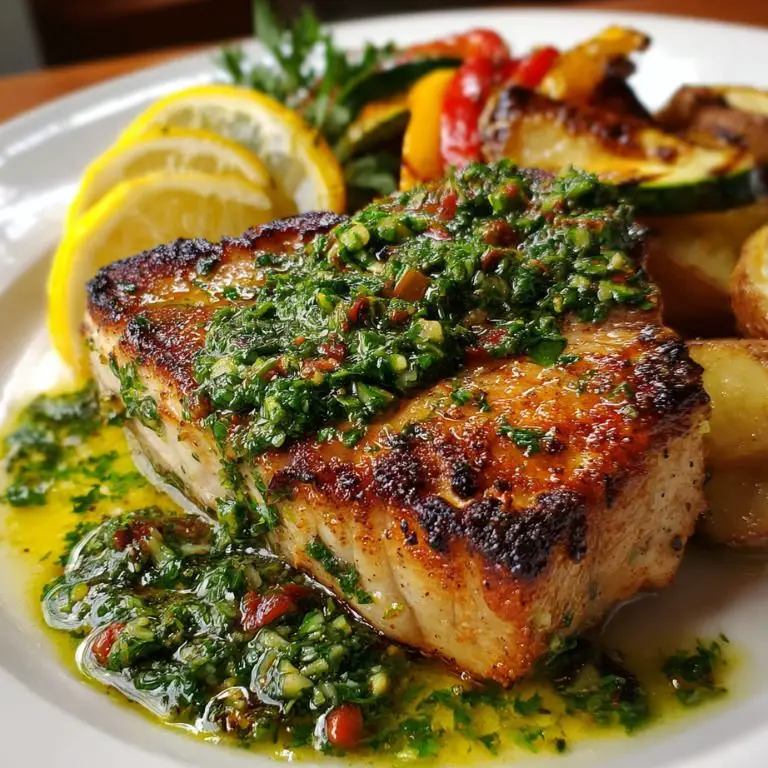Pan‑Seared Swordfish with Chimichurri is a vibrant and bold dish that transforms simple swordfish steaks into a celebration for your taste buds. With lemon‑bright chimichurri dripping over perfectly seared fish, each bite delivers a satisfying contrast between the meaty, slightly sweet swordfish and the fresh herbaceous sauce. I love turning this into a weeknight ritual or a weekend dinner centerpiece—no fuss but maximum flavor. Think of it as the elite cousin of sea bass fillet recipes—just a little more robust, a little more showy.
Pan‑Seared Swordfish with Chimichurri
Prep Time 15 minutes mins
Cook Time 8 minutes mins
Total Time 23 minutes mins
Course Main Course
Cuisine American, Argentinian, Mediterranean
Heavy‑bottomed skillet or cast‑iron pan essential for a seared crust; non‑stick pan is an alternative but won’t deliver the same color.
Tongs or fish spatula for gently turning steaks.
Chef’s knife and board to prep herbs for chimichurri.
Measuring spoons and cups to keep seasoning balanced.
Small Mixing Bowl for chimichurri prep (or use a mason jar).
Plate lined with paper towels (optional) rest the fish if you’re juggling pans.
- Swordfish steak: 2 steaks ~6 oz each, about 1–1¼″ thick, skin removed
- Olive oil: 3 tablespoons divided
- Kosher salt: 1½ teaspoons
- Freshly ground black pepper: 1 teaspoon
- Garlic powder: ½ teaspoon
- Smoked paprika: ½ teaspoon optional, adds smokiness like blackened swordfish recipes
- Lemon wedges: 4
- Butter: 1 tablespoon optional, for finishing
Chimichurri Sauce
- Flat‑leaf parsley: 1 cup finely chopped
- Fresh cilantro: ½ cup finely chopped
- Fresh oregano: 2 tablespoons finely chopped
- Garlic: 3 cloves minced (about 1 tablespoon)
- Red wine vinegar: 2 tablespoons
- Olive oil: ½ cup
- Red pepper flakes: ¼ teaspoon adjust to taste
- Salt and pepper: to taste
- Zest of 1 lemon optional, brightens the sauce
Prepare the Chimichurri
Finely chop parsley, cilantro, oregano, and garlic.
Combine in a bowl with red wine vinegar, olive oil, red pepper flakes, lemon zest, salt, and pepper.
Whisk or stir until emulsified.
Let it rest for at least 10 minutes (or refrigerate up to 4 hours) to meld flavors.
Season the Swordfish
Pat steaks dry with paper towels (essential for a crisp crust).
Brush or rub each steak with 1 tablespoon of olive oil.
Sprinkle with salt, pepper, garlic powder, and smoked paprika (if using).
Gently press seasoning to adhere.
Heat the Pan
Warm a heavy skillet over medium‑high heat for about 2–3 minutes until very hot.
Add 1 tablespoon of olive oil and swirl to coat.
Sear the Swordfish
Carefully place steaks in the skillet. Should sizzle instantly.
Cook undisturbed for 3½–4 minutes to form a golden crust.
Flip once using tongs or spatula.
Add butter to pan and spoon melted butter over the top for 2–3 minutes more.
Fish should register about 130°F (55°C) on an instant‑read thermometer—opaque at edges, slightly translucent center. Cooking to medium ensures moist texture.
Rest & Sauce
Transfer steaks to a plate; let them rest for 2 minutes.
Spoon vibrant chimichurri generously over each steak.
Serve with lemon wedges for extra zing.
Pairings
Side Dishes
- Roasted Fingerling Potatoes: Olive oil, garlic, rosemary – light crispness.
- Grilled Vegetables: Zucchini, bell peppers, asparagus; tie into grilled swordfish themes.
- Citrus Arugula Salad: Peppery greens, grapefruit segments, shaved fennel, olive oil.
- Corn Esquites‑Style Salad: Inspired by Mexican street corn with lime, mayo, cotija cheese—acidic balance to the fish.
Beverages
- White Wine: Crisp Sauvignon Blanc, Albariño, or Verdejo—bright acidity.
- Rosé: Dry rosé with mineral notes complements both swordfish and chimichurri.
- Beer: Belgian witbier or pale ale; light and citrusy.
- Mocktail: Sparkling water, mint, cucumber, lime.
Sauce Swaps
- Salsa Verde: Italian parsley, capers, anchovy, lemon.
- Mango‑Jalapeño Salsa: Sweet, spicy fruit twist.
- Citrus Butter Sauce: Melted butter, lemon juice, garlic, shallots – rich, complementary.
FAQs
1. What kind of swordfish steak should I use—thick-cut, thin, bone-in or boneless?
Use a boneless center‑cut steak about 1–1¼″ thick, typically 6‑8 oz. That thickness ensures you can get a nice crust while keeping the interior tender and juicy. Thinner steaks can overcook or dry out, while extra‑thick cuts (>1.5″) may need heavier seasoning or oven‑finishing.
2. Can I substitute chicken or salmon instead of swordfish?
This method works great as a blueprint for other steaks: salmon steak recipes work well with chimichurri—just reduce cooking time. If using chicken, pound fillets to even thickness, pat dry, then sear and baste similarly, though cook until chicken reaches a safe 165°F.
3. Is swordfish like a flatiron steak or fish steak?
It’s a fish steak—similar in shape to a flatiron steak but of course delicate. The texture is dense and firm, so it holds up to high‑heat pan searing without flaking apart.
4. How do I know when the swordfish is done?
Use an instant‑read thermometer in the center: 130°F yields medium‑rare to medium, perfect for moisture. If you like it more done, up to 135°F is okay. Over 145°F starts drying it out. Visually, the flesh should be opaque with a hint of translucence.
5. Can I make this chimichurri ahead?
Absolutely! It actually improves after an hour in the fridge. Keep it in an airtight container for up to 2 days. Bring back to room temperature before serving or drizzle directly from the fridge—the flavors meld even when chilled.
